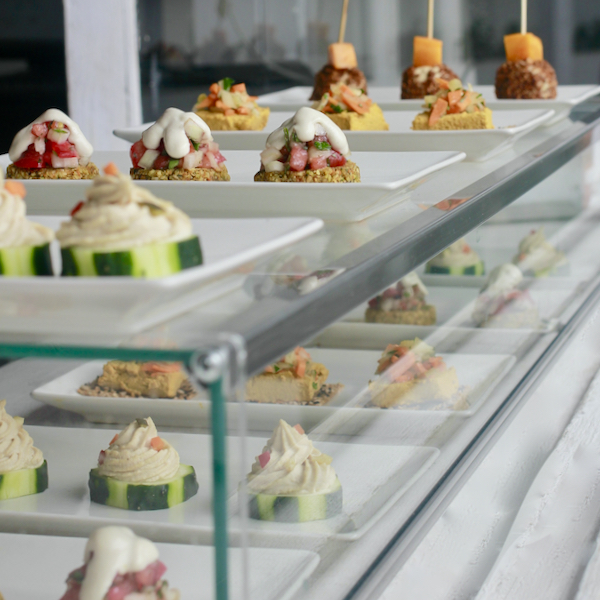
A few months ago we gave a catering service in a unique place, The Floating House in Tarifa, Spain. One of the dishes we served was our chickpea hummus. We decided to tune it to a brutal warm day with a few hints of coriander, lemon peel and ginger. One of the guests, Eva Carpinelli, Marine Biologist and founder of the Nereide association for the conservation of the marine ecosystem of the Strait of Gibraltar, approached us and said: This is the best hummus I’ve ever tasted. Can you give me the recipe?
The Quotidian Cooks looked at each other, smiled and answered in chorus: Whaaat? … If it’s a secret recipe: impossible! But … yes, it was a joke and we described it among more laughs. Today we are sharing this refreshing recipe after explaining the importance and difference of making hummus at home.

Hummus is a traditional Egyptian dish and its ingredients are humble and Mediterranean: chickpeas, tahini, lemon, garlic, olive oil and salt. To prepare it, they are all crushed in a blender until obtaining a smooth and dense cream that is seasoned with paprika, cumin, sesame seeds or other spices. It is quite surprising that the most widespread option to eat Hummus is to buy an industrial one at the supermarket. And here’s where the problems begin …
A recently published study by the Dutch Consumer Association shows how manipulated Hummus spreads found in supermarkets are. They tested 74 Hummus packages for ingredientes and found that average content of chickpeas was between 30-50 per cent. What is the rest? Sunflower oil, starches, flavor, sugars, etc. They also compared calories per 200 gr pack. And they go from 220 (67 % chickpeas) to 740 Kcal (37 % chickpeas). Is Hummus healthy? Rarely, if you buy it in the supermarket. (We found a similar study made by the Spanish Consumer Association that you can read in the Spanish version of this post).
Disappointing is to say the least, since this is a classic ultra-processed food. If we look at the ingredient labels we will be even more depressed because in order to get a flavor of Hummus they add Natural Flavors, the secret ingredient of Fake Foods and that everything disturbs. We recommend you our post on flavors added to food (very unnatural, really) and, on the same page, a recipe well away from the ultra-processed: Polenta and Sage Flatbreads.
Our Hummus is the easiest and fastest recipe to make of all the ones we have published. To give it a touch of its own, we refresh it with lemon peel and ginger and we also brighten it with an aromatic dressing: garlic and fresh coriander. On top, a good dose of the same whole chickpeas and a good splash of EVOO. It’s what we call a Maximized Hummus.
As you can imagine, you can adjust it to your liking by tuning the dressing. Cumin, sesame seeds, paprika, a hot chili as in the picture, etc. etc. The result is a light, creamy Hummus with a bite of whole chickpeas. A cheerful and refreshing dish with a clear flavor of chickpeas and sesame and where the lemon and ginger, very subtle, make the guests exclaim: really good!
And we say goodbye asking you to join the Campaign promoted by the Nereide Association Stop Finning of Sharks. A European citizens’ initiative to stop the indiscriminate hunting of sharks to market their fins.
- 600g freshly cooked or bought chickpeas
- 3 tbs Raw Tahini paste
- 3cm piece fresh ginger, peeled and grated
- 2 tbsp olive oil
- 1 small garlic clove
- 1 or 2 lemons
- Mineral water
- Sea salt
- For the dressing
- 60ml olive oil
- 1 strip lemon peel cut in thin slices
- 1 large garlic clove, peeled and thinly sliced
- 2cm piece fresh ginger, peeled and julienned
- 1 tbs coriander stalks, cut in pieces plus 2 tbsp picked leaves
- With a vegetable peeler cut 6 strips of lemon peel and squeeze the lemon.
- For the dressing, reserve 100 gr of chickpeas and a strip of lemon peel.
- In the blender vase, place the chickpeas, lemon juice, tahini, garlic clove, grated ginger, 5 strips of lemon peel, 50 ml of water and salt.
- Blend thoroughly until we obtain a very fine puree, we test the texture and if necessary add one or two tablespoons of water and we blend again until we obtain the desired texture, smooth and spreadable.
- Try it and rectify the point of salt and lemon. Reserve the mixture in the fridge.
- For the dressing
- In a frying pan place the oil over medium heat, lightly brown the garlic strips and add the green coriander stems, cut into pieces, the lemon peel strip cut into strips and the julienned ginger. Sauté for 2-3 minutes and turn off the heat.
- To serve, place the Hummus in a flat dish, distribute the reserved chickpeas on top and refresh with the dressing.
- Garnish with the coriander leaves and a splash of extra virgin olive oil.











Leave a Reply